Abstract
Aquatic pollution, which includes organic debris and heavy metals, is a severe issue for living things. Copper pollution is hazardous to people, and there is a need to develop effective methods for eliminating it from the environment. To address this issue, a novel adsorbent composed of frankincense-modified multi-walled carbon nanotubes (Fr-MMWCNTs) and Fe3O4 [Fr-MWCNT-Fe3O4] was created and subjected to characterization. Batch adsorption tests showed that Fr-MWCNT-Fe3O4 had a maximum adsorption capacity of 250 mg/g at 308 K and could efficiently remove Cu2+ ions over a pH range of 6 to 8. The adsorption process followed the pseudo-second-order and Langmuir models, and its thermodynamics were identified as endothermic. Functional groups on the surface of modified MWCNTs improved their adsorption capacity, and a rise in temperature increased the adsorption efficiency. These results highlight the Fr-MWCNT-Fe3O4 composites’ potential as an efficient adsorbent for removing Cu2+ ions from untreated natural water sources.
1. Introduction
The addition of diverse pollutants, including heavy metals and organic matter, has changed the water’s natural composition. Eliminating heavy metals from water using adsorbents is an ongoing study area for fundamental research and practical applications [1,2]. The scientific and engineering communities face challenges regarding the expense, specificity, and efficient separation of these adsorbents from water [3,4]. Among these heavy metal ions, the copper ion (Cu2+) is particularly problematic during the electroplating process since it is more likely to leak into the water supply as a pollutant. Excessive exposure to copper ions can result in the development of chromosomal recessive [5]. The World Health Organization recommends a maximum of 2.0 mg/L copper concentration in drinking water, establishing the level at which copper should be controlled [6]. Essential techniques like chemical precipitation, electrochemistry, membrane technology, adsorption, and chemical reduction technology have been applied to eliminate Cu (II) ions from wastewater [7,8]. The targeted method depends on the purpose, operational cost, and treatment criteria. Adsorption techniques have seen the most utilization out of all methods over the past few years due to various advantages [9]. It is easy to use, very effective, inexpensive, and positively affects the environment. The adsorbents are capable of regenerating themselves, and this method produces no additional by-products [10]. Activated carbon with a size of a few nanometers, graphene oxide, and carbon nanotubes (CNTs) are just a few examples of the various forms of carbonaceous materials that have so far been manipulated as raw materials to create various adsorbents [11]. CNTs are a potential candidate among these materials because they have good electrical, chemical, and mechanical properties. Because of their excellent electrical, chemical, and mechanical characteristics, CNTs are the most suitable adsorbent materials [12,13]. There are two significant advantages to these materials. Firstly, they possess a higher surface area than other materials. Second, they can absorb various contaminants via electronic hydrophobic interactions because of the hexagonal arrangement of the atoms on their surface [14,15]. Numerous studies have highlighted the immense capacity of CNTs to adsorb various organic/inorganic pollutants [16,17]. CNTs are made of sp2-hybridized carbon atoms that exhibit unique properties, are highly polarizable, and have little ability to hold water. The separation of carbon nanotubes from solutions continues to be challenging [18].
Magnetic separation is a highly efficient physical separation method that is beneficial for recycling small nanoparticles in water purification processes. This method is characterized by its ability to achieve high separation efficiency using minimal energy [19]. Moreover, magnetic separation offers the additional benefit of preventing the aggregation of nanoparticles in the solution, as the added magnetism helps to keep the particles dispersed and separate from each other. Magnetic separation is a quick, easy, and cheap way to separate magnetic adsorbents from treated media after they have taken up pollutants. It is faster and more affordable than filtration and centrifugation.
Recently, metal oxide/CNTs nanocomposites have been the subject of extensive research and have proven to be highly useful adsorbents for removing heavy metals from wastewater [20]. Rahmani et al. used co-precipitation to make a magnetic nanocomposite of MnFe2O4 and bentonite that can adsorb Co(II) ions from wastewater. The nanocomposite proved to be very good at adsorbing Co(II) ions, which suggests that it could be an effective way to get heavy metals out of polluted water [21]. Chen et al. developed Fe3O4/CNTs magnetic nanoparticles that effectively eliminated Cr(VI) from wastewater. The nanoparticles demonstrated excellent magnetic separation efficiency at low magnetic field gradients [22]. Wang and colleagues developed a hybrid adsorbent composed of γ-PGA-Fe2O4-GO-(o-MWCNTs) nanomaterials, demonstrating high efficiency in the adsorption of metal ions from contaminated water [23]. Yin and colleagues developed a multifunctional adsorbent of metal–organic frameworks (MOFs), UiO-66, decorated with Fe2O3 magnetic nanoparticles, termed UiO-66@Fe2O3@UiO-66, for the efficient elimination of cosmetics and pharmaceuticals from water [24]. A magnetic CoFe-LDH/g-C3N4 nanocomposite reported by Ou et al. successfully removed the Cr(Ⅵ) from aqueous solution [25].
Due to their effectiveness, specificity, reusability, and affordability, metal oxide nanoparticles are a viable option for the removal of heavy metal ions [26]. Many research projects have successfully removed metal ions via nanoadsorbents made of metal oxides such as Fe2O3, ZnO, TiO2, etc. [27,28,29]. Fe3O4 nanoparticles are highly appealing for modifying CNTs due to their distinct magnetic properties compared to other metal oxide nanoparticles. With nanoadsorbent technology, pollution-related problems can be solved affordably and sustainably [30]. This technology can effectively remove or minimize various pollutants, including organic and inorganic contaminants, while avoiding the generation of harmful by-products and toxic intermediates. Their toxicity and pollutant removal time are disadvantages [29,31]. Modifying capping agents with active groups can enhance adsorption efficiency [32,33]. The toxicity problem can be solved by using organic plant materials as stabilizing and capping agents and techniques for making nanoadsorbents that are safe for the environment [34,35]. We previously described the synthesis of Au and Pd nanoparticles from frankincense resin and the efficiency of these particles in catalyzing dye degradation [36,37].
The current investigation suggests a sustainable approach to synthesizing modified frankincense resin gum-multiwalled carbon nanotube-iron oxide nanoadsorbents (Fr-MWCNT-Fe3O4). Various techniques were used to characterize the synthesized materials, including UV/visible spectroscopy, TEM, SEM, FTIR, XRD, DLS, and zeta potential. The primary goal of this study is to assess the effectiveness of these nanoadsorbents in eliminating Cu2+ ions from industrial wastewater. The study systematically examined various adsorption models, including adsorption isotherms, kinetics, and thermodynamics models. The nanomaterial exhibited exceptional magnetic separation and adsorption capabilities. Moreover, the potential environmental applications of this adsorbent were assessed in the study.
2. Results and Discussion
2.1. Characterization of Fr-MMWCNT and Fr-MMWCNT-Fe3O4
The peaks observed in the frankincense-based multiwalled carbon nanotube (Fr-MMWCNT) FTIR spectrum (Figure 1) at 2330.6 cm−1 correspond to the -C–O bonds, 2115.8 cm−1 and 2088.9 cm−1 correspond to the carbon–carbon triple bond (C≡C) in nitrile and isocyanide, 1990.3 cm−1 to (C=C) in the aromatic ring of the frankincense-based compound, and 1834.1 cm−1 to the carbonyl group (C=O) in the ester functional groups, respectively [38,39,40,41,42]. The FTIR peaks observed in the multiwalled carbon with iron oxide composite at 2117.59 cm−1, 1995.73 cm−1, 2329 cm−1, 2089 cm−1, and 614 cm−1 correspond to various stretching vibrations (Figure 1). The transmittance peak observed at 2117.59 cm−1 designates the presence of C–C stretching vibrations in the carbon nanotubes. The peak detected at 1995.73 cm−1 is attributed to C–O stretching vibrations, indicating the presence of oxygen-containing functional groups on the carbon nanotube surface [43]. The peak observed at 2089 cm−1 is attributed to C=C stretching vibrations, representing the carbon-carbon double bonds in the carbon nanotubes. Finally, the peak observed at 614 cm−1 is due to the Fe–O stretching vibrations of the iron oxide nanoparticles, indicating the existence of iron oxide on the carbon nanotube surface [44].
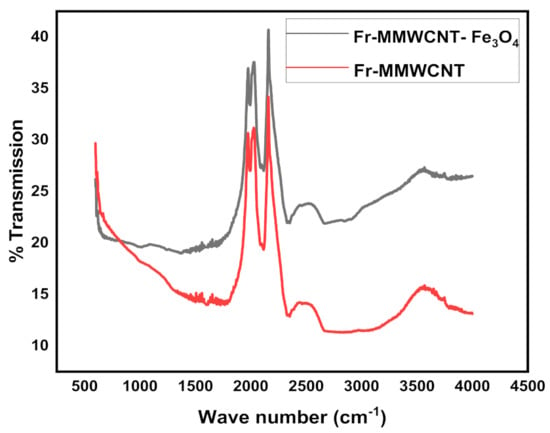
Figure 1.
FT-IR spectra of Fr-MMWCNT and Fr-MMWCNT-Fe3O4.
In the X-ray diffraction pattern of the Fr-MMWCNT, the peaks observed at 2θ values of 26.24° and 42.5° correspond to the (002) and (110) planes of the MWCNTs structure [45,46]. In the pattern of the Fr-MMWCNT-Fe3O4 (Figure 2), the peaks observed at 2θ values of 26.24° and 42.5° correspond to the (002) and (110) planes of the MWCNTs structure, respectively (Figure S1. JCPDS No. 01-1061) [47]. The XRD pattern of Fr-MMWCNT-Fe3O4 reveals weak diffraction peaks for MWCNTs, indicating that the CNT’s structure is preserved in the composite material [11]. The diffraction peaks observed at 2θ values of 30.65°, 35.98°, 43.49°, 57.56°, and 63.22° are attributed to the presence of iron oxide nanoparticles (Figure S2. JCPDS No. 00-2321) in the corresponding (202), (311), (400), (511), and (404) planes of the Fe3O4 structure. This confirms the presence of the magnetic structure of the Fe3O4 nanoparticles in the composite without any impurities [12].
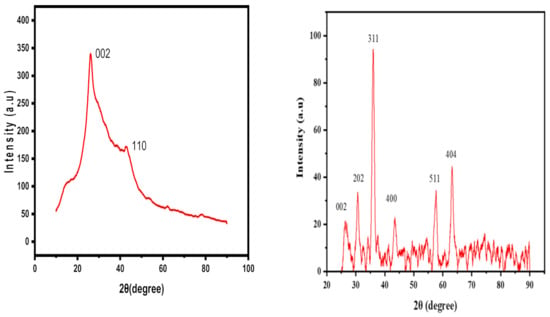
Figure 2.
XRD peaks for Fr-MMWCNT and Fr-MMWCNT-Fe3O4.
The Fr-MMWCNT composite’s scanning electron microscopy (SEM) image indicated a coating of Fr-gum on the nanotubes, as seen in the SEM image (Figure 3a). According to EDS analysis of the samples, carbon and oxygen were found in a ratio of 91.47% to 8.53%. The scanning electron microscope (SEM) image of the Fr-MMWCNT-Fe3O4 composite revealed that the nanotube surfaces were covered with a layer of Fr-gum, indicating the successful preparation of the composite (Figure 4a). Additionally, the SEM image showed the presence of randomly distributed magnetite nanoparticles on the surface of the composite. The distribution of magnetite particles appeared to be clustered, meaning that the particles were not evenly distributed across the surface. The clustering of magnetite particles could be due to several reasons.
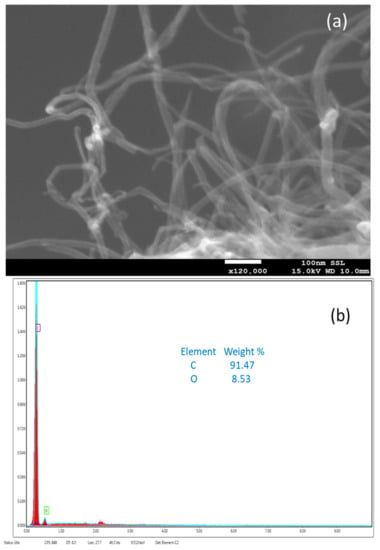
Figure 3.
SEM (a) and EDS (b) of Fr-MMWCNT.
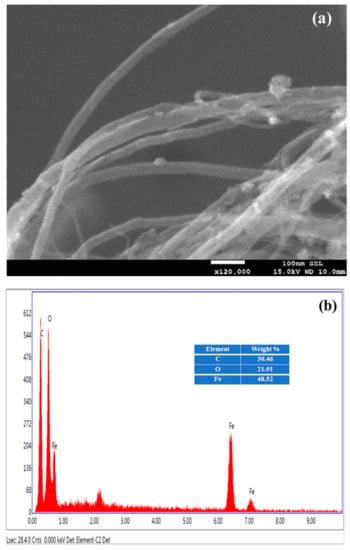
Figure 4.
SEM (a) and EDS (b) of Fr-MMWCNT-Fe3O4 composite.
Overall, the SEM image of the Fr-MMWCNT-Fe3O4 composite provides valuable insight into the morphology and structure of the composite material, showing the presence of Fr-gum on the nanotube surface and the distribution of magnetite particles in clusters.
The EDS analysis has detected the presence of carbon, oxygen, and iron in the ratio of 30.46% carbon, 21.01% oxygen, and 48.52% iron in the Fr-MMWCNT-Fe3O4 composite (Figure 4b).
The HRTEM evaluation of the Fr-MMWCNT-Fe3O4 composite discloses a carbon nanotube with a cylindrical shape enclosed by gum material and iron oxide nanoparticles around it (Figure 5). These particles are randomly dispersed over the carbon nanotube. The distance between the two carbon layers is measured to be 15–60 nm, while the diameter of the nanotube is approximately 9–13 nm. The iron oxide nanoparticles display assorted sizes, ranging from 10–25 nm. The carbon nanotubes are several micrometers in length and exhibit smooth surfaces and substantial specific surface areas. The diffraction rings observed in the SAED image verify the magnetite nanoparticles’ crystalline nature in the composite.
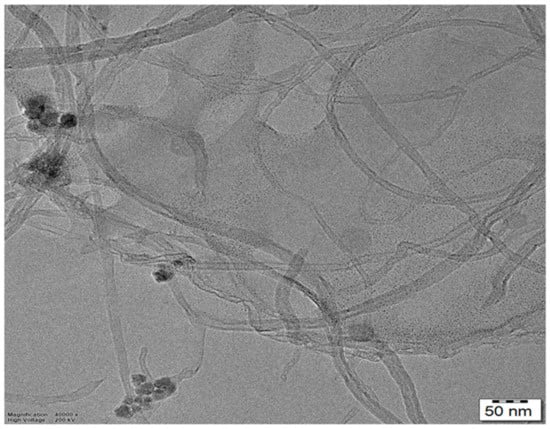
Figure 5.
HRTEM of Fr-MMWCNT-Fe3O4 composite.
2.2. Adsorption Parameters
Since pH impacts the charge on the surface of copper ions and adsorbents, the pH variation affects the effectiveness of metal removal. According to the results, copper ion removal efficiency increases up to a pH of 8, but it starts to decrease after that point. The impact of pH on the adsorption of Cu2+ ions in solution is illustrated by a qe vs. pH graph (Figure 6a). From Figure 6b, it is evident that increasing the dosage of the adsorbent material raises the adsorption proficiency up to 0.05 g; however, higher dosages slightly decrease efficiency. When more adsorbent was added, more adsorption sites became available, which may have initially resulted in higher adsorption, but as the dosage was increased, adsorbent aggregation caused the value of qe to decrease. Thus, the observed optimum dosage of the composite was 0.05 g [48].
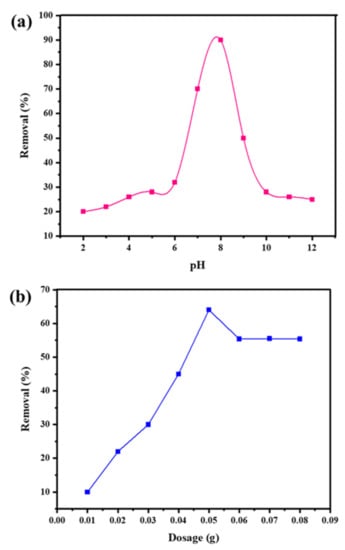
Figure 6.
Effect of change in pH (a) and change in dosage (b) of Fr-MMWCNT-Fe3O4 on the removal of copper ions.
The effect of the contact time on the metal removal efficiency is exhibited in Figure 7a. As the contact time goes up, the removal rate goes up until 30 min, when it stays the same. Since, at the start, more empty sites are available; the Cu ion removal is fast. Nevertheless, as equilibrium is reached, it remains constant. Figure 7b explains the relationship between the adsorption efficiency of the Fr-MMWCNT-Fe3O4 composite and the initial concentration of Cu2+ ions. It is evident from Figure 7b that the removal efficiency also depends on the initial concentration of Cu2+ ions. The higher the initial concentrations of Cu2+ ions, the better the removal efficiency, and vice versa. The removal efficiency of Cu2+ ions shows a steady increase with an increase in concentration; however, a small dip is observed at 20 ppm, which could probably be due to an analysis error. Figure 7c shows that the stirring time has an impact on the removal efficiency of Cu2+ ions by the Fr-MMWCNT-Fe3O4 composite. The figure shows that as the stirring speed increases, the removal efficiency also increases. These results suggest that optimal conditions for the efficient removal of Cu2+ ions can be achieved by adjusting pH, dosage, contact time, initial concentration, and stirring speed.
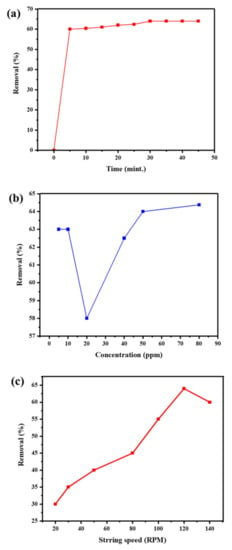
Figure 7.
Effect of contact time (a), concentration of Cu2+ ions (b), and stirring time (c) on adsorption efficiency of Fr-MMWCNT-Fe3O4.
2.3. Adsorption Isotherm Study
Isotherms describe a solid-solution adsorption system’s adsorption behavior. The adsorption isotherm explains how adsorbate is distributed across the solid and liquid phases at equilibrium. The adsorption mechanism was investigated by utilizing the three adsorption isotherms. It was discovered that the Langmuir and Freundlich models better fit the equilibrium data than the Temkin model. These two models were better at predicting equilibrium data than the Temkin model. Langmuir yielded a maximum adsorption capacity (qmax) of 250 mg/g and a Langmuir constant (KL) of 0.014 L/mg. The Freundlich model showed a high affinity for the adsorbate with a Freundlich constant (KF) of 3.119 (mg/g) × (L/mg)(1/n) and a Freundlich exponent (n) of 0.994. The Temkin model had a lower R2 value and a weaker interaction [49]. Parameter results of the Langmuir, Freundlich, and Temkin models are mentioned in Table 1. The fact that Freundlich and Langmuir’s isotherms have a high correlation coefficient suggests that adsorbents have different kinds of active sites and that monolayer MB adsorption onto the Fr-MMWCNT-Fe3O4 occurs. Cu2+ ion adsorption was good. Overall, the Langmuir and Freundlich models provide a better fit for designing adsorption systems to remove the target adsorbate from the solution (Figure 8a,b).

Table 1.
Adsorption isotherm results for Cu2+ adsorption on Fr-MMWCNT-Fe3O4 at different temperatures.
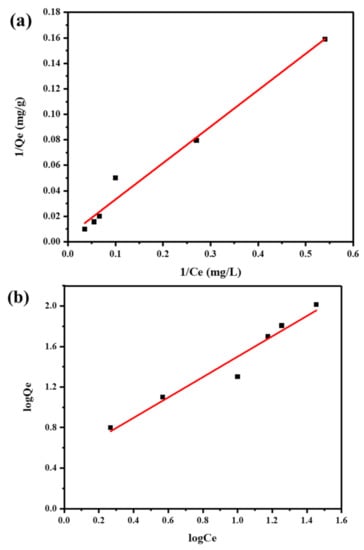
Figure 8.
Adsorption isotherms of Cu2+ ions by Fr-MMWCNT-Fe3O4, the fitting plots of the Langmuir model (a), and Freundlich model (b).
2.4. Kinetics of Adsorption
Adsorption kinetic models are essential for characterizing adsorption mechanisms due to their ability to predict equilibrium adsorption capacity and rate [50]. The PFO and PSO models are commonly used to describe the adsorption of a solute onto a solid adsorbent [51]. In contrast to the PSO model, which predicted a chemical reaction in adsorption, the PFO model predicted that physisorption was the primary catalyst for the reaction process. The given data provides information on the adsorption of Cu2+ ions on a nanocomposite at different temperatures. In the given data (Table 2), we can see that the values of k1 and R2 for the PFO model are reported for each temperature. The R2 values for the PFO model are comparatively low, which suggests that this model may not be the best fit for the adsorption system [52]. Therefore, it can be concluded that the rate of adsorption of Cu2+ ions on the nanocomposite is not well explained by the PFO model [53]. In the given data (Table 2), we can see that the values of k2 and R2 for the PSO model are reported for each temperature. The R2 values for the PSO model are relatively high, indicating that this model provides an excellent fit to the experimental data (Figure 9a,b) [54]. Therefore, it can be concluded that the rate of adsorption of Cu2+ ions on the nanocomposite is well described by the PSO model [55].

Table 2.
Kinetic modeling results.
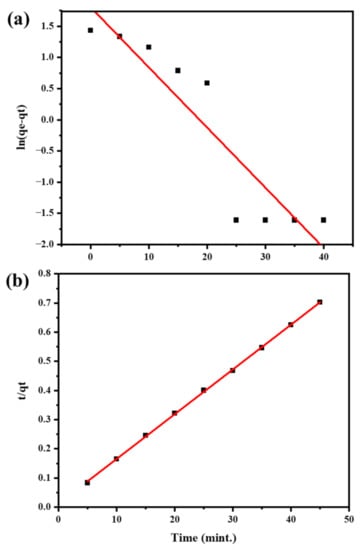
Figure 9.
Adsorption kinetics of Cu2+ ions on the Fr-MMWCNT-Fe3O4 with kinetic modeling pseudo-first order (a) and pseudo-second order (b).
2.5. Thermodynamics of Adsorption
The thermodynamic parameters include the change in Gibbs free energy (ΔG°), the change in enthalpy (ΔH°), and the change in entropy (ΔS°) [56].
The plot of LnKd vs. 1/T is a representation of the thermodynamic model (shown in Figure 10 and Table 3). The data show that the ΔG° values at all temperatures are negative, indicating that the adsorption of Cu2+ ions onto the composite is a spontaneous process (Table 3) [57]. However, the values of ΔH° and ΔS° are only provided for the adsorption process at 308 K, with a ΔH° value of 11.62 kJ/mol and a ΔS° value of 67.42 J/mol.K [58]. These values indicate that the adsorption process is endothermic and leads to an increase in the disorder of the system [59].
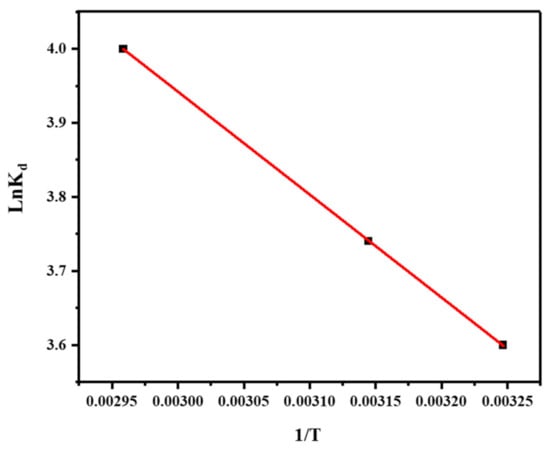
Figure 10.
Thermodynamic modeling (Plot of lnKd vs. 1/T).

Table 3.
Thermodynamic study results.
2.6. Comparison of Adsorption Capacity of Fr-MMWCNT-Fe3O4 with Other Adsorbents
Table 4 presents a comparison of the removal efficiency of Cu2+ ions and the isotherm model for Fr-MMWCNT-Fe3O4 (current study) with those of other previous carbon-based adsorbents. Compared to the earlier reported data (Table 4), the maximum adsorption capacity of Fr-MMWCNT-Fe3O4 is significantly higher. This unequivocally establishes the efficacy of Fr-MMWCNT-Fe3O4 as adsorbents with regard to the removal of Cu2+ ions. The adsorption of Cu2+ ions on Fr-MMWCNT-Fe3O4 fits well with the Langmuir isotherm model, suggesting that a mono-layer adsorption process is taking place. This is also true for other types of adsorbents.

Table 4.
Maximum adsorption capacities (qmax) and isotherm models of some reported carbon-based adsorbents for the removal of Cu+2.
3. Materials and Methods
3.1. Materials
MWCNTs used in the study were procured from Adnano Technologies Private Limited, India. The MWCNTs had a purity of 99%, an outer diameter of 10–30 nm, an inner diameter of 5–10 nm, a length of over several micrometers, and a surface area of 110–350 m2/g. The frankincense gum used in the study was of the Hojari variety and was obtained from a local market. Analytical-grade ferric chloride and ferrous ammonium sulphate were purchased from EduChem in India. HCl and NaOH solutions were prepared at 0.1 M concentrations for pH adjustments and were obtained from SD Fine Chemical in India. Sulphuric acid (H2SO4, 98%) and nitric acid (HNO3, 71%) were purchased from Thomas Baker in India.
3.2. Preparation of Fr-MMWCNT and Fr-MMWCNT-Fe3O4
To create the oxidized MMWCNT, 150 mL of a 1:1 mixture of concentrated HNO3 and H2SO4 was used to treat the MWCNT, which was then refluxed for 8 h. The resulting product was filtered, washed twice with distilled water (DW) until it reached a neutral pH, and dried. Fr-MMWCNT was prepared by stirring 0.4 g of Fr with 1.0 g of oxidized MWCNT at 50 °C for 8 h. The nanocomposite was collected via filtration, washed with DW, sonicated, and dried. The Fr-MMWCNT-Fe3O4 was produced by suspending 1.0 g of Fr-MWCNT in a 100 mL solution consisting of 0.845 g FeCl3·6H2O and 0.425 g FeSO4·7H2O, followed by the addition of 10 mL of an 8 mol L−1 NH3 solution to maintain the pH between 10 and 11. The mixture was stirred for 4 h at 60 °C under an N2 atmosphere and then washed with DW to reach a neutral pH. The subsequent composite was dried at approximately 80 °C. The magnetic composite, Fr-MMWCNT-Fe3O4, was characterized using various methods, including FT-IR, TGA, XRD, EDS, SEM, and HRTEM.
3.3. Instrumentation
The FT-IR spectra of the Fr-MMWCNT-Fe3O4 composites were obtained using a Cary 630 FTIR instrument from Agilent Technologies (Stevens Creek, Santa Clara, CA, USA), within the range of 500 cm−1 to 4000 cm−1. XRD spectra were taken at room temperature using CuKα radiation (λ = 0.15406 nm, V = 30 kV, I = 30 mA) in the 2θ range of 4°–90°. SEM images were taken using two different instruments: VEGA 3 SBH from TESCAN Brno S.R.O. in the Czech Republic and SEM JEOL GSM 7600F, while EDS spectra were recorded on an SEM/EDS (at 5 kV voltage) instrument from EDAX Inc. (Pleasanton, CA, USA). High-resolution TEM images were captured at a resolution of 0.2 Å using a TEM-JEM-2100 plus instrument from JEOL (Tokyo, Japan). The absorbance of Cu2+ solutions was measured on an AA-7800 atomic absorption spectrophotometer (Tokyo, Japan). A 2100 pH meter from Pine Brook, (Parsippany, NJ 07054, USA) was used to measure pH.
3.4. Adsorption Studies
To conduct the adsorption experiments, 0.05 g of composite was mixed with 100 mL of a copper sulphate solution at room temperature. The mixture was then magnetically stirred for 1 h, and subsequently centrifuged at 5000 RPM for 15 min. The AAS (AA-7800) was employed to measure the amount of copper adsorbed. The copper removal via adsorption was assessed by changing experimental conditions such as solution pH, contact time, stirring speed, solution concentration, and composite dose. The following equation was used to compute the % removal of copper:
where Ci and C0 are the initial and final concentrations of copper in mg/L.
% Removal of Copper = [(Ci − C0)/Ci] × 100
The effect of pH on the adsorption of Cu2+ ions was studied using solutions with pH = 2–12 and measuring the absorbance at a constant temperature. The effect of stirring speed on copper removal was examined by changing it from 0 to 45 min. The effects of stirring speed on copper removal were studied by varying it from 20 to 140 RPM, while the effect of the number of nanoparticles used was studied by changing the dosage from 0.01 g to 0.08 g. Finally, the impact of the initial concentration of copper ions on the removal efficiency was examined by altering the concentration of the copper from 5 to 80 ppm in solution.
3.5. Adsorption Isotherm
Langmuir, Freundlich, and Temkin are three commonly used models to describe the adsorption of Cu2+ ions onto a solid surface.
The Langmuir model is based on the assumption of monolayer adsorption, in which the surface contains a fixed number of active sites and each site can only adsorb one Cu ion [69]. According to this model (Equation (2)), the equilibrium adsorption capacity (qe) is related to the equilibrium concentration of Cu2+ ions in solution (Ce) by the Langmuir isotherm equation [70]:
where qmax is the maximum adsorption capacity of the surface and KL is the Langmuir constant, which is related to the affinity of the surface for Cu2+ ions.
qe = (qmax × KL × Ce)/(1 + KL × Ce)
Conversely, the Freundlich model proposes that adsorption occurs on a heterogeneous surface with various adsorption energies. According to this model, the qe is related to the Ce of Cu2+ ions in solution by the Freundlich isotherm equation [71]:
qe = KF × Ce(1/n)
The adsorption capacity of the surface is related to the Freundlich constant (KF), and the surface heterogeneity is related to the Freundlich linearity index (n).
The Temkin model proposes that the adsorption energy of Cu2+ ions on the surface decreases linearly with coverage, which means that the heat of adsorption declines logarithmically with surface coverage. According to this model, the qe is related to the Ce of Cu2+ ions in solution by the Temkin isotherm equation [72]:
where KT is the Temkin constant, A is the heat of adsorption constant, and B is the universal gas constant. These models can be used to fit experimental data and determine the relevant parameters, such as qmax, KL, KF, n, KT, and A, which provide insight into the adsorption behavior of Cu2+ ions on a surface.
qe = B ln(KT Ce) + B ln(A)
3.6. Kinetics of Adsorption
To find the best-suited kinetic model, adsorption data was applied to pseudo-first-order (PFO) and pseudo-second-order (PSO) models to study the kinetics of the adsorption of Cu2+ ions onto adsorbent surfaces.
3.6.1. Pseudo First Order
The PFO model is based on the supposition that the adsorption rate is directly proportional to the concentration of Cu2+ ions adhering to the adsorbent surface at any given time [73]. The mathematical equation for the PFO model is given as [74]:
where qe is the equilibrium adsorption capacity (mg/g), qt is the amount of Cu2+ ions adsorbed on the adsorbent at time t (mg/g), k1 is the rate constant for the PFO model (min−1), and t is the time (min). By plotting log(qe − qt) versus t, a linear graph can be obtained from which the rate constant can be calculated.
log(qe − qt) = logqe − k1t/2.303
3.6.2. Pseudo Second Order
The PSO model is based on the assumption that the adsorption rate is directly proportional to the square of the concentration of the Cu2+ ions remaining on the surface of the adsorbent at any given time. The mathematical equation for the PSO model is given as [75]:
where qe is the equilibrium adsorption capacity (mg/g), qt is the quantity of Cu2+ ions adsorbed on the adsorbent at time t (mg/g), k2 is the rate constant for the PSO model (g/mg min), and t is the time (min). By plotting t/qt versus t, a linear graph can be obtained from which the rate constant and equilibrium adsorption capacity can be calculated. By comparing the correlation coefficients and other statistical parameters, the best-fit model can be selected for the Cu ion adsorption process.
t/qt = 1/k2(qe2) + t/qe
3.7. The Thermodynamics of Adsorption
Thermodynamics of adsorption refers to the study of the energy changes that occur during the adsorption of a substance onto a surface. It helps in understanding the spontaneity, feasibility, and stability of the adsorption process.
The thermodynamic parameters used to describe adsorption are entropy change (ΔS°), Gibbs free energy change (ΔG°), and enthalpy change (ΔH°). The following equations are applied to calculate these parameters [56]:
where K and R are the equilibrium and gas constants, respectively, while T is the absolute temperature.
ΔG° = −RTlnK
ΔH° = −RT2(d lnK/d(1/T))
ΔS° = −R(d lnK/dT)
4. Conclusions
In this study, a novel composite of frankincense gum multi-walled carbon nanotubes with magnetic Fe3O4 nanoparticles (Fr-MMWCNT-Fe3O4) was prepared and characterized. The results indicated that the MWCNTs formed a composite with the Fr-gum and magnetite nanoparticles, with the latter randomly clustered in the gum material surrounding the CNTs. The composite was evaluated as an adsorbent for the removal of the emerging pollutant Cu2+ ions from an aqueous solution. The findings demonstrated that Fr-MMWCNT-Fe3O4 is a highly effective adsorbent for the remediation of Cu2+ ions, with a maximum adsorption capacity of 250 mg/g. The Langmuir model was found to be the most suitable for explaining the adsorption process, which was determined to be endothermic, spontaneous, and following a physisorption mechanism. This study suggests that more research is desirable to explore the potential of Fr-MMWCNT-Fe3O4 for adsorbing other pollutants, including pharmaceuticals, dyes, and organic substances.
Supplementary Materials
The following supporting information can be downloaded at: https://www.mdpi.com/article/10.3390/molecules28114494/s1, Figure S1. Diffraction peak spectra of Fr-MMWCNT. Figure S2. Diffraction peak spectra of Fr-MMWCNT-Fe3O4. References [76,77] are cited in the supplementary materials.
Author Contributions
Conceptualization, M.H.; data curation, S.S.H.; formal analysis, M.S. and S.A.A.; funding acquisition, M.H.; investigation, M.H.; methodology, S.S.H.; project administration, K.S.; resources, A.A.A.; supervision, M.A.S.; validation, M.S., S.H.A. and W.A.-G.; visualization, S.K.A. and A.-N.M.A.A.; writing—original draft, M.H.; writing—review and editing, M.S. and H.A. All authors have read and agreed to the published version of the manuscript.
Funding
The authors express their gratitude to the Ministry of Higher Education, Research, and Innovation (MoHERI), Sultanate of Oman, for the research grant (Research Grant No. BFP/RGP/EBR/21/225).
Institutional Review Board Statement
Not applicable.
Informed Consent Statement
Not applicable.
Data Availability Statement
Not applicable.
Conflicts of Interest
The authors declare no conflict of interest.
Sample Availability
Samples of the compounds are available from the authors.
References
- Javed, M.; Qamar, M.A.; Shahid, S.; Alsaab, H.O.; Asif, S. Highly efficient visible light active Cu–ZnO/SgC 3 N 4 nanocomposites for efficient photocatalytic degradation of organic pollutants. RSC Adv. 2021, 11, 37254–37267. [Google Scholar] [CrossRef] [PubMed]
- Hussain, S.; Alam, M.M.; Imran, M.; Ali, M.A.; Ahamad, T.; Haidyrah, A.S.; Alotaibi, S.M.R.; Shariq, M. A facile low-cost scheme for highly photoactive Fe3O4-MWCNTs nanocomposite material for degradation of methylene blue. Alex. Eng. J. 2022, 61, 9107–9117. [Google Scholar] [CrossRef]
- Ritchie, H.; Roser, M. Urbanization, 2018. Our World Data. Available online: https://ourworldindata.org/urbanization (accessed on 24 April 2023).
- Qamar, M.A.; Javed, M.; Shahid, S.; Shariq, M.; Fadhali, M.M.; Ali, S.K.; Khan, M.S. Synthesis and applications of graphitic carbon nitride (g-C3N4) based membranes for wastewater treatment: A critical review. Heliyon 2023, 9, e12685. [Google Scholar] [CrossRef] [PubMed]
- Squitti, R.; Faller, P.; Hureau, C.; Granzotto, A.; White, A.R.; Kepp, K.P. Copper imbalance in Alzheimer’s disease and its link with the amyloid hypothesis: Towards a combined clinical, chemical, and genetic etiology. J. Alzheimer’s Dis. 2021, 83, 23–41. [Google Scholar] [CrossRef]
- Shariq, M.; BaQais, A.; Althagafi, T.M.; Madkhali, O.; Alholaisi, A.A.; Hussain, S.; Javed, Y. Synthesis of Co3O4/NiO nanospherical composites as electrode material for high-performance supercapacitors. Eur. Phys. J. Plus 2023, 138, 389. [Google Scholar] [CrossRef]
- Azimi, A.; Azari, A.; Rezakazemi, M.; Ansarpour, M. Removal of Heavy Metals from Industrial Wastewaters: A Review. ChemBioEng Rev. 2017, 4, 37–59. [Google Scholar] [CrossRef]
- Qamar, M.A.; Shahid, S.; Javed, M.; Shariq, M.; Fadhali, M.M.; Madkhali, O.; Ali, S.K.; Syed, I.S.; Awaji, M.Y.; Shakir Khan, M.; et al. Accelerated Decoloration of Organic Dyes from Wastewater Using Ternary Metal/g-C3N4/ZnO Nanocomposites: An Investigation of Impact of g-C3N4 Concentration and Ni and Mn Doping. Catalysts 2022, 12, 1388. [Google Scholar] [CrossRef]
- Wang, D.; Chen, Y.; Jarin, M.; Xie, X. Increasingly frequent extreme weather events urge the development of point-of-use water treatment systems. Npj Clean Water 2022, 5, 36. [Google Scholar] [CrossRef]
- Cheng, K.; Cai, Z.; Fu, J.; Sun, X.; Sun, W.; Chen, L.; Zhang, D.; Liu, W. Synergistic adsorption of Cu (II) and photocatalytic degradation of phenanthrene by a jaboticaba-like TiO2/titanate nanotube composite: An experimental and theoretical study. Chem. Eng. J. 2019, 358, 1155–1165. [Google Scholar] [CrossRef]
- Wang, Z.; Xu, W.; Jie, F.; Zhao, Z.; Zhou, K.; Liu, H. The selective adsorption performance and mechanism of multiwall magnetic carbon nanotubes for heavy metals in wastewater. Sci. Rep. 2021, 11, 16878. [Google Scholar] [CrossRef]
- Zhao, P.; Geng, T.; Zhao, Y.; Tian, Y.; Li, J.; Zhang, H.; Zhao, W. Removal of Cu (Ⅱ) ions from aqueous solution by a magnetic multi-wall carbon nanotube adsorbent. Chem. Eng. J. Adv. 2021, 8, 100184. [Google Scholar] [CrossRef]
- Bassyouni, M.; Mansi, A.E.; Elgabry, A.; Ibrahim, B.A.; Kassem, O.A.; Alhebeshy, R. Utilization of carbon nanotubes in removal of heavy metals from wastewater: A review of the CNTs’ potential and current challenges. Appl. Phys. A 2019, 126, 38. [Google Scholar] [CrossRef]
- Asghar, A.; Yousaf, M.I.; Shad, N.A.; Sajid, M.M.; Afzal, A.M.; Javed, Y.; Razzaq, A.; Shariq, M.; Gulfam, Q.-U.; Sarwar, M.; et al. Enhanced Electrochemical Performance of Hydrothermally Synthesized NiS/ZnS Composites as an Electrode for Super-Capacitors. J. Clust. Sci. 2021, 33, 2325–2335. [Google Scholar] [CrossRef]
- Wang, Z.; Tang, H.; Li, W.; Li, J.; Xu, R.; Zhang, K.; He, G.; Shearing, P.R.; Brett, D.J. Core–shell TiO 2@ C ultralong nanotubes with enhanced adsorption of antibiotics. J. Mater. Chem. A 2019, 7, 19081–19086. [Google Scholar] [CrossRef]
- Zhao, W.; Tian, Y.; Chu, X.; Cui, L.; Zhang, H.; Li, M.; Zhao, P. Preparation and characteristics of a magnetic carbon nanotube adsorbent: Its efficient adsorption and recoverable performances. Sep. Purif. Technol. 2020, 257, 117917. [Google Scholar] [CrossRef]
- Sarkar, B.; Mandal, S.; Tsang, Y.F.; Kumar, P.; Kim, K.-H.; Ok, Y.S. Designer carbon nanotubes for contaminant removal in water and wastewater: A critical review. Sci. Total. Environ. 2018, 612, 561–581. [Google Scholar] [CrossRef]
- Aftab, S.; Iqbal, M.Z.; Rim, Y.S. Recent Advances in Rolling 2D TMDs Nanosheets into 1D TMDs Nanotubes/Nanoscrolls. Small 2023, 19, 2205418. [Google Scholar] [CrossRef]
- Hui, M.; Shengyan, P.; Yaqi, H.; Rongxin, Z.; Anatoly, Z.; Wei, C. A highly efficient magnetic chitosan “fluid” adsorbent with a high capacity and fast adsorption kinetics for dyeing wastewater purification. Chem. Eng. J. 2018, 345, 556–565. [Google Scholar] [CrossRef]
- Fiyadh, S.S.; AlSaadi, M.A.; Jaafar, W.Z.; AlOmar, M.K.; Fayaed, S.S.; Mohd, N.S.; Hin, L.S.; El-Shafie, A. Review on heavy metal adsorption processes by carbon nanotubes. J. Clean. Prod. 2019, 230, 783–793. [Google Scholar] [CrossRef]
- Rahmani, A.; Karimi, G.R.; Hosseini, M. Removal/separation of Co (II) ion from environmental sample solutions by MnFe2O4/bentonite nanocomposite as a magnetic nanomaterial. Desalination Water Treat. 2017, 89, 250–257. [Google Scholar] [CrossRef]
- Chen, R.; Chai, L.; Li, Q.; Shi, Y.; Wang, Y.; Mohammad, A. Preparation and characterization of magnetic Fe3O4/CNT nanoparticles by RPO method to enhance the efficient removal of Cr (VI). Environ. Sci. Pollut. Res. 2013, 20, 7175–7185. [Google Scholar] [CrossRef]
- Wang, L.; Hu, D.; Kong, X.; Liu, J.; Li, X.; Zhou, K.; Zhao, H.; Zhou, C. Anionic polypeptide poly (γ-glutamic acid)-functionalized magnetic Fe3O4-GO-(o-MWCNTs) hybrid nanocomposite for high-efficiency removal of Cd (II), Cu (II) and Ni (II) heavy metal ions. Chem. Eng. J. 2018, 346, 38–49. [Google Scholar] [CrossRef]
- Yin, Y.; Shi, M.; Ren, Y.; Wang, S.; Hua, M.; Lu, J.; Zhang, W.; Lv, L. Wrinkle structure on multifunctional MOFs to facilitate PPCPs adsorption in wastewater. Chem. Eng. J. 2020, 387, 124196. [Google Scholar] [CrossRef]
- Ou, B.; Wang, J.; Wu, Y.; Zhao, S.; Wang, Z. Efficient removal of Cr (VI) by magnetic and recyclable calcined CoFe-LDH/g-C3N4 via the synergy of adsorption and photocatalysis under visible light. Chem. Eng. J. 2020, 380, 122600. [Google Scholar] [CrossRef]
- Sher, M.; Javed, M.; Shahid, S.; Iqbal, S.; Qamar, M.A.; Bahadur, A.; Qayyum, M.A. The controlled synthesis of gC 3 N 4/Cd-doped ZnO nanocomposites as potential photocatalysts for the disinfection and degradation of organic pollutants under visible light irradiation. RSC Adv. 2021, 11, 2025–2039. [Google Scholar] [CrossRef] [PubMed]
- El-Sayed, M.E. Nanoadsorbents for water and wastewater remediation. Sci. Total. Environ. 2020, 739, 139903. [Google Scholar] [CrossRef]
- Gutierrez, A.M.; Dziubla, T.D.; Hilt, J.Z. Recent advances on iron oxide magnetic nanoparticles as sorbents of organic pollutants in water and wastewater treatment. Rev. Environ. Health 2017, 32, 111–117. [Google Scholar] [CrossRef]
- Ali, M.E.; Hoque, M.E.; Hossain, S.K.S.; Biswas, M.C. Nanoadsorbents for wastewater treatment: Next generation biotechnological solution. Int. J. Environ. Sci. Technol. 2020, 17, 4095–4132. [Google Scholar] [CrossRef]
- Qamar, M.A.; Javed, M.; Shahid, S.; Iqbal, S.; Abubshait, S.A.; Abubshait, H.A.; Ramay, S.M.; Mahmood, A.; Ghaithan, H.M. Designing of highly active g-C3N4/Co@ ZnO ternary nanocomposites for the disinfection of pathogens and degradation of the organic pollutants from wastewater under visible light. J. Environ. Chem. Eng. 2021, 9, 105534. [Google Scholar] [CrossRef]
- Zhu, Y.; Liu, X.; Hu, Y.; Wang, R.; Chen, M.; Wu, J.; Wang, Y.; Kang, S.; Sun, Y.; Zhu, M. Behavior, remediation effect and toxicity of nanomaterials in water environments. Environ. Res. 2019, 174, 54–60. [Google Scholar] [CrossRef]
- Orooji, Y.; Mortazavi-Derazkola, S.; Ghoreishi, S.M.; Amiri, M. Mesopourous Fe3O4@ SiO2-hydroxyapatite nanocomposite: Green sonochemical synthesis using strawberry fruit extract as a capping agent, characterization and their application in sulfasalazine delivery and cytotoxicity. J. Hazard. Mater. 2020, 400, 123140. [Google Scholar] [CrossRef] [PubMed]
- Obey, G.; Adelaide, M.; Ramaraj, R. Biochar derived from non-customized matamba fruit shell as an adsorbent for wastewater treatment. J. Bioresour. Bioprod. 2022, 7, 109–115. [Google Scholar] [CrossRef]
- Dikshit, P.K.; Kumar, J.; Das, A.K.; Sadhu, S.; Sharma, S.; Singh, S.; Gupta, P.K.; Kim, B.S. Green Synthesis of Metallic Nanoparticles: Applications and Limitations. Catalysts 2021, 11, 902. [Google Scholar] [CrossRef]
- Jjagwe, J.; Olupot, P.W.; Menya, E.; Kalibbala, H.M. Synthesis and Application of Granular Activated Carbon from Biomass Waste Materials for Water Treatment: A Review. J. Bioresour. Bioprod. 2021, 6, 292–322. [Google Scholar] [CrossRef]
- Al Washahi, K.K.O.; Alkende, N.S.M.; Reddy, G.B.; Seku, K. Frankincense resin mediated green method for optimized biosynthesis of gold nanoparticles for simple and visual detection of Cu2+ ions. Mater. Today Proc. 2021, 43, 1376–1382. [Google Scholar] [CrossRef]
- Seku, K.; Hussaini, S.S.; Golla, N.; Rapolu, S.; Bandi, R.; Reddy, B. Microwave-assisted synthesis of palladium nanoparticles using Frankincense resin and evaluation of their catalytic properties. Mater. Lett. 2020, 278, 128427. [Google Scholar] [CrossRef]
- Zhao, Z.; Yang, Z.; Hu, Y.; Li, J.; Fan, X. Multiple functionalization of multi-walled carbon nanotubes with carboxyl and amino groups. Appl. Surf. Sci. 2013, 276, 476–481. [Google Scholar] [CrossRef]
- Regert, M.; Devièse, T.; LE Hô, A.; Rougeulle, A. Reconstructing ancient Yemeni commercial routes during the Middle Ages using structural characterization of terpenoid resins. Archaeometry 2008, 50, 668–695. [Google Scholar] [CrossRef]
- Ma, P.C.; Kim, J.-K.; Tang, B.Z. Functionalization of carbon nanotubes using a silane coupling agent. Carbon 2006, 44, 3232–3238. [Google Scholar] [CrossRef]
- Chiang, I.W.; Brinson, B.E.; Smalley, R.E.; Margrave, J.L.; Hauge, R.H. Purification and Characterization of Single-Wall Carbon Nanotubes. J. Phys. Chem. B 2001, 105, 1157–1161. [Google Scholar] [CrossRef]
- Misra, A.; Tyagi, P.; Rai, P.; Misra, D.S. FTIR Spectroscopy of Multiwalled Carbon Nanotubes: A Simple Approachto Study the Nitrogen Doping. J. Nanosci. Nanotechnol. 2007, 7, 1820–1823. [Google Scholar] [CrossRef] [PubMed]
- Temnuch, N.; Suwattanamala, A.; Inpaeng, S.; Tedsree, K. Magnetite nanoparticles decorated on multi-walled carbon nanotubes for removal of Cu2+ from aqueous solution. Environ. Technol. 2020, 42, 3572–3580. [Google Scholar] [CrossRef] [PubMed]
- Boruah, P.K.; Borah, D.J.; Handique, J.; Sharma, P.; Sengupta, P.; Das, M.R. Facile synthesis and characterization of Fe3O4 nanopowder and Fe3O4/reduced graphene oxide nanocomposite for methyl blue adsorption: A comparative study. J. Environ. Chem. Eng. 2015, 3, 1974–1985. [Google Scholar] [CrossRef]
- Singh, D.K.; Iyer, P.; Giri, P. Diameter dependence of interwall separation and strain in multiwalled carbon nanotubes probed by X-ray diffraction and Raman scattering studies. Diam. Relat. Mater. 2010, 19, 1281–1288. [Google Scholar] [CrossRef]
- Zhang, Q.; Zhu, M.; Zhang, Q.; Li, Y.; Wang, H. The formation of magnetite nanoparticles on the sidewalls of multi-walled carbon nanotubes. Compos. Sci. Technol. 2009, 69, 633–638. [Google Scholar] [CrossRef]
- Yao, C.; Li, J.; Zhang, Z.; Gou, C.; Zhang, Z.; Pan, G.; Zhang, J. Hierarchical Core–Shell Co2N/CoP Embedded in N, P-doped Carbon Nanotubes as Efficient Oxygen Reduction Reaction Catalysts for Zn-air Batteries. Small 2022, 18, 2108094. [Google Scholar] [CrossRef]
- Duan, Z.; Zhang, W.; Lu, M.; Shao, Z.; Huang, W.; Li, J.; Li, Y.; Mo, J.; Li, Y.; Chen, C. Magnetic Fe3O4/activated carbon for combined adsorption and Fenton oxidation of 4-chlorophenol. Carbon 2020, 167, 351–363. [Google Scholar] [CrossRef]
- Bezzina, J.P.; Robshaw, T.; Dawson, R.; Ogden, M.D. Single metal isotherm study of the ion exchange removal of Cu (II), Fe (II), Pb (II) and Zn (II) from synthetic acetic acid leachate. Chem. Eng. J. 2020, 394, 124862. [Google Scholar] [CrossRef]
- Javed, M.; Iqbal, S.; Qamar, M.A.; Shariq, M.; Ahmed, I.A.; BaQais, A.; Alzahrani, H.; Ali, S.K.; Masmali, N.A.; Althagafi, T.M.; et al. Fabrication of Effective Co-SnO2/SGCN Photocatalysts for the Removal of Organic Pollutants and Pathogen Inactivation. Crystals 2023, 13, 163. [Google Scholar] [CrossRef]
- Ezzati, R. Derivation of Pseudo-First-Order, Pseudo-Second-Order and Modified Pseudo-First-Order rate equations from Langmuir and Freundlich isotherms for adsorption. Chem. Eng. J. 2019, 392, 123705. [Google Scholar] [CrossRef]
- Rajendran, S.; Priya, A.; Kumar, P.S.; Hoang, T.K.; Sekar, K.; Chong, K.Y.; Khoo, K.S.; Ng, H.S.; Show, P.L. A critical and recent developments on adsorption technique for removal of heavy metals from wastewater-A review. Chemosphere 2022, 303, 135146. [Google Scholar] [CrossRef] [PubMed]
- Sahoo, T.R.; Prelot, B. Adsorption processes for the removal of contaminants from wastewater: The perspective role of nanomaterials and nanotechnology. In Nanomaterials for the Detection and Removal of Wastewater Pollutants; Elsevier: Amsterdam, The Netherlands, 2020; pp. 161–222. [Google Scholar]
- Bullen, J.C.; Saleesongsom, S.; Gallagher, K.; Weiss, D.J. A Revised Pseudo-Second-Order Kinetic Model for Adsorption, Sensitive to Changes in Adsorbate and Adsorbent Concentrations. Langmuir 2021, 37, 3189–3201. [Google Scholar] [CrossRef]
- Bujdák, J. Adsorption kinetics models in clay systems. The critical analysis of pseudo-second order mechanism. Appl. Clay Sci. 2020, 191, 105630. [Google Scholar] [CrossRef]
- Du, X.; Cheng, Y.; Liu, Z.; Yin, H.; Wu, T.; Huo, L.; Shu, C. CO2 and CH4 adsorption on different rank coals: A thermodynamics study of surface potential, Gibbs free energy change and entropy loss. Fuel 2020, 283, 118886. [Google Scholar] [CrossRef]
- Hu, C.; Zhu, P.; Cai, M.; Hu, H.; Fu, Q. Comparative adsorption of Pb (II), Cu (II) and Cd (II) on chitosan saturated montmorillonite: Kinetic, thermodynamic and equilibrium studies. Appl. Clay Sci. 2017, 143, 320–326. [Google Scholar] [CrossRef]
- Ben Khalifa, E.; Rzig, B.; Chakroun, R.; Nouagui, H.; Hamrouni, B. Application of response surface methodology for chromium removal by adsorption on low-cost biosorbent. Chemom. Intell. Lab. Syst. 2019, 189, 18–26. [Google Scholar] [CrossRef]
- Fito, J.; Tefera, N.; Van Hulle, S.W. Adsorption of distillery spent wash on activated bagasse fly ash: Kinetics and thermodynamics. J. Environ. Chem. Eng. 2017, 5, 5381–5388. [Google Scholar] [CrossRef]
- Zhang, X.; Huang, Q.; Liu, M.; Tian, J.; Zeng, G.; Li, Z.; Wang, K.; Zhang, Q.; Wan, Q.; Deng, F.; et al. Preparation of amine functionalized carbon nanotubes via a bioinspired strategy and their application in Cu2+ removal. Appl. Surf. Sci. 2015, 343, 19–27. [Google Scholar] [CrossRef]
- Jiang, D.B.; Yuan, S.; Cai, X.; Xiang, G.; Zhang, Y.X.; Pehkonen, S.; Liu, X.Y. Magnetic nickel chrysotile nanotubes tethered with pH-sensitive poly (methacrylic acid) brushes for Cu (II) adsorption. J. Mol. Liq. 2019, 276, 611–623. [Google Scholar] [CrossRef]
- Xiao, D.-L.; Li, H.; He, H.; Lin, R.; Zuo, P.-L. Adsorption performance of carboxylated multi-wall carbon nanotube-Fe3O4 magnetic hybrids for Cu(II) in water. New Carbon Mater. 2014, 29, 15–25. [Google Scholar] [CrossRef]
- Dou, J.; Gan, D.; Huang, Q.; Liu, M.; Chen, J.; Deng, F.; Zhu, X.; Wen, Y.; Zhang, X.; Wei, Y. Functionalization of carbon nanotubes with chitosan based on MALI multicomponent reaction for Cu2+ removal. Int. J. Biol. Macromol. 2019, 136, 476–485. [Google Scholar] [CrossRef] [PubMed]
- Bayazit, S.; Inci, I. Adsorption of Cu (II) ions from water by carbon nanotubes oxidized with UV-light and ultrasonication. J. Mol. Liq. 2014, 199, 559–564. [Google Scholar] [CrossRef]
- Wu, C.-H. Studies of the equilibrium and thermodynamics of the adsorption of Cu2+ onto as-produced and modified carbon nanotubes. J. Colloid Interface Sci. 2007, 311, 338–346. [Google Scholar] [CrossRef]
- Li, Y.-H.; Ding, J.; Luan, Z.; Di, Z.; Zhu, Y.; Xu, C.; Wu, D.; Wei, B. Competitive adsorption of Pb2+, Cu2+ and Cd2+ ions from aqueous solutions by multiwalled carbon nanotubes. Carbon 2003, 41, 2787–2792. [Google Scholar] [CrossRef]
- Moradi, O.; Zare, K.; Monajjemi, M.; Yari, M.; Aghaie, H. The studies of equilibrium and thermodynamic adsorption of Pb (II), Cd (II) and Cu (II) ions from aqueous solution onto SWCNTs and SWCNT–COOH surfaces. Fuller. Nanotub. Carbon Nanostructures 2010, 18, 285–302. [Google Scholar] [CrossRef]
- Zeng, G.; Liu, X.; Liu, M.; Huang, Q.; Xu, D.; Wan, Q.; Huang, H.; Deng, F.; Zhang, X.; Wei, Y. Facile preparation of carbon nanotubes based carboxymethyl chitosan nanocomposites through combination of mussel inspired chemistry and Michael addition reaction: Characterization and improved Cu2+ removal capability. J. Taiwan Inst. Chem. Eng. 2016, 68, 446–454. [Google Scholar] [CrossRef]
- Tomczyk, A.; Sokołowska, Z.; Boguta, P. Biomass type effect on biochar surface characteristic and adsorption capacity relative to silver and copper. Fuel 2020, 278, 118168. [Google Scholar] [CrossRef]
- Sabry, D.; El-Shahat, M.F. Heavy metals removal from aqueous solution using magnetite Dowex 50WX4 resin nanocomposite. J. Mater. 2017, 8, 503–511. [Google Scholar]
- Kowanga, K.D.; Gatebe, E.; Mauti, G.O.; Mauti, E.M. Kinetic, sorption isotherms, pseudo-first-order model and pseudo-second-order model studies of Cu (II) and Pb (II) using defatted Moringa oleifera seed powder. J. Phytopharm. 2016, 5, 71–78. [Google Scholar] [CrossRef]
- Benzaoui, T.; Selatnia, A.; Djabali, D. Adsorption of copper (II) ions from aqueous solution using bottom ash of expired drugs incineration. Adsorpt. Sci. Technol. 2017, 36, 114–129. [Google Scholar] [CrossRef]
- Khamwichit, A.; Dechapanya, W.; Dechapanya, W. Adsorption kinetics and isotherms of binary metal ion aqueous solution using untreated venus shell. Heliyon 2022, 8, e09610. [Google Scholar] [CrossRef] [PubMed]
- Dou, D.; Wei, D.; Guan, X.; Liang, Z.; Lan, L.; Lan, X.; Liu, P.; Mo, H.; Lan, P. Adsorption of copper (II) and cadmium (II) ions by in situ doped nano-calcium carbonate high-intensity chitin hydrogels. J. Hazard. Mater. 2021, 423, 127137. [Google Scholar] [CrossRef] [PubMed]
- An, B. Cu(II) and As(V) Adsorption Kinetic Characteristic of the Multifunctional Amino Groups in Chitosan. Processes 2020, 8, 1194. [Google Scholar] [CrossRef]
- Hassel, O. Ueber die Kristallstruktur des Graphits. Z. Fuer Phys. 1924, 25, 317–337. [Google Scholar] [CrossRef]
- Haavik, C.; Stolen, S.; Fjellvag, H.; Hanfland, M.; Hausermann, D. Equation of state of magnetite and its high-pressure modification: Thermodynamics of the Fe-O system at high pressure Sample at P = 6.6 GPa. Am. Mineral. 2000, 85, 514–523. [Google Scholar] [CrossRef]
Disclaimer/Publisher’s Note: The statements, opinions and data contained in all publications are solely those of the individual author(s) and contributor(s) and not of MDPI and/or the editor(s). MDPI and/or the editor(s) disclaim responsibility for any injury to people or property resulting from any ideas, methods, instructions or products referred to in the content. |
© 2023 by the authors. Licensee MDPI, Basel, Switzerland. This article is an open access article distributed under the terms and conditions of the Creative Commons Attribution (CC BY) license (https://creativecommons.org/licenses/by/4.0/).